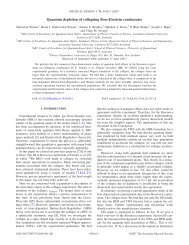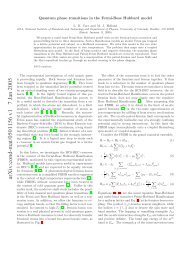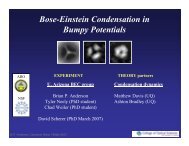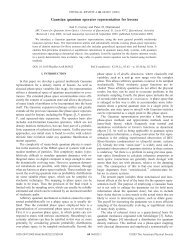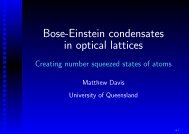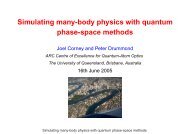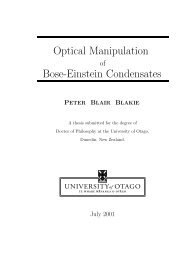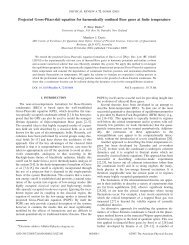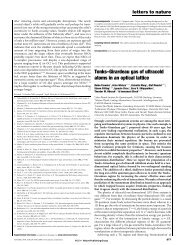Open Quantum Dynamics of Mesoscopic Bose-Einstein ... - Physics
Open Quantum Dynamics of Mesoscopic Bose-Einstein ... - Physics
Open Quantum Dynamics of Mesoscopic Bose-Einstein ... - Physics
Create successful ePaper yourself
Turn your PDF publications into a flip-book with our unique Google optimized e-Paper software.
6. <strong>Quantum</strong> effects in optical fibre communications systemsless than a gain length. However, for short pulses, this distance can still correspond tomany dispersion lengths, thus generating large position jitter.As is well known, the noise due to gain and loss in the fibre produces the Gordon-Hauseffect, which is currently considered the major limiting factor in any long-distance solitonbasedcommunications system using relatively long (> 10ps) pulses. Amplification withmean intensity gain α G , chosen to compensate fibre loss, produces a diffusion (or jitter)in position. Unless other measures are taken, for sufficiently small amplifier spacing[129]and at large distances this is given by[70, 76, 102]〈(∆τ(ζ))2 〉 GH ≃ αG9n ζ3 (bright), (6.44a)〈(∆τ(ζ))2 〉 GH ≃ αG18n ζ3 (dark), (6.44b)in which the linearly growing terms have been neglected.Another effect <strong>of</strong> the amplifier noise is to introduce an extra noise term via the fluctuationsin the Raman-induced soliton self-frequency shift. This term scales as the fifthpower <strong>of</strong> distance and hence will become important for long propagation distances. Thiscombined effect <strong>of</strong> spontaneous emission noise and the Raman intrapulse scattering hasbeen dealt with by a number <strong>of</strong> authors[7, 123, 134, 182]. Equation (6.11) models thisaccurately, since it includes the delayed Raman nonlinearity, and the effect would be seenin numerical simulations carried out over long propagation distances.A lesser known effect is the fluctuations in velocity that arise from the Raman phasenoiseterm Γ R in Eq. (6.11). Like the Gordon-Haus effect, this Raman noise generates acubic growth in jitter variance:〈(∆τ(ζ))2 〉 R = 2I(t 0)3n ζ3 (bright), (6.45a)〈(∆τ(ζ))2 〉 R = I(t 0)6n ζ3 (dark). (6.45b)where I(t 0 ) is the integral defined in Eq. (6.34) that indicates the spectral overlap betweenthe pulse spectrum and the Raman fluorescence. The mean-square Raman-induced timingjitter has a cubic growth in both cases, but the dark soliton variance is one quarter <strong>of</strong> that<strong>of</strong> the bright soliton.The magnitude <strong>of</strong> this Raman jitter can be found by evaluating I(t 0 ) numerically, orelse using an analytic approximation. An accurate model <strong>of</strong> the Raman gain, on whichI(t 0 ) depends, requires a multi-Lorentzian fit to the experimentally measured spectrum. A135



